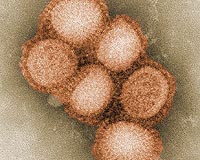 Shortcomings abound in South America's war on swine flu
Shortcomings abound in South America's war on swine flu
by Staff Writers
Montevideo Aug 20, 2009
Alarmist warnings, slow distribution of drugs, and a failure of authorities to coordinate: critics are zeroing in on the failed policies to fight swine flu in South America as the pandemic spreads across the region.
With the southern hemisphere reaching the height of winter, cases of A(H1N1) are rising and authorities are still trying to determine the best methods to contain the pandemic.
Several experts, for example, doubt that school closures that were widespread across the region have had much effect on halting the swine flu spread.
"It has a limited effect," said Chilean epidemiologist Luiz Martinez Oliva. He added that neither do closed borders contribute to "halting the pandemic."
Brazil's health ministry reported Tuesday that the swine flu has killed 368 people, but that the figures were likely higher because it was behind the toll kept by individual states.
The bulk of the victims died in southern Brazil, especially in heavily-populated Sao Paulo state and the states bordering on Argentina, Uruguay and Paraguay.
Argentina in early May suspended for two weeks all flights to Mexico when that country was ground zero of the global pandemic. It also extended winter school vacations in July in an attempt to halt the spread of the virus.
It was all for naught, as Argentina now has the second highest number of swine flu cases after the United States: as of August 13, more than 400 people have died and nearly 800,000 have contracted the illness.
The head of the National Flu Center, Vilma Savy, said that her laboratory has lacked the necessary manpower to handle the suspected swine flu samples in the past weeks because employees had to stay home to take care of their children due to school closures.
Jorge Yabkowski, president of the Argentine Federation of Health Professionals, blames authorities for the spread of the disease.
One of the reasons for the high mortality rate was the delay in using anti-retroviral medicine while medical personnel waited for confirmation that they were facing swine flu cases, Yabkowski said.
The decision to administer the medicine when swine flu symptoms appeared was taken "only on 29 June and entered into effect on 4 July, while the pandemic peaked in Argentina between 20 and 27 June," he said.
During that week the country suffered its highest rate of swine flu deaths and hospitalizations, Yabkowski said.
Also affecting the national response was the resignation of Health Minister Graciela Ocana on June 29 following a defeat for President Cristina Kirchner's supporters in midterm elections.
The result was a lack of top leadership just as the pandemic was peaking, even as coordination was weak between national and state regional authorities.
Savy also blasted the failure of health authorities across the region to communicate with their people. Swine flu information was often limited to a daily toll of cases and deaths "without giving any context, which only contributes to a sense of panic," she said.
Many people came to believe that contracting the A(H1N1) was akin to a death sentence, said Brazilian epidemiologist Fabio Franco.
On the positive side, Uruguayan epidemiologist Eduardo Savio said that information campaigns urging people to remain home when sick "has prevented a collapse of the health system" by avoiding the spread of the virus inside hospitals.
In Chile, the swine flu has killed 116 people, while more than 12,000 have been infected, authorities said Wednesday, while in Peru authorities on Monday reported that the virus had killed 62 people and 6,121 have been infected, though most are now healthy.
Share This Article With Planet Earth
Related Links
Epidemics on Earth - Bird Flu, HIV/AIDS, Ebola

 Latin America swine flu deaths climb to 1,300
Latin America swine flu deaths climb to 1,300
Sao Paulo (AFP) Aug 19, 2009
Deaths from swine flu in Latin America -- the worst-hit region in the world -- rose to over 1,300 on Wednesday after governments added to tolls from the disease. Brazil late Tuesday said its count climbed to 368 deaths, putting it just behind Argentina which, with 404 deaths, has the second-highest fatality tally in the world. The United States has 477 deaths. South America has seen the ... read more
|
 |
|

 Latin America swine flu deaths climb to 1,300
Latin America swine flu deaths climb to 1,300